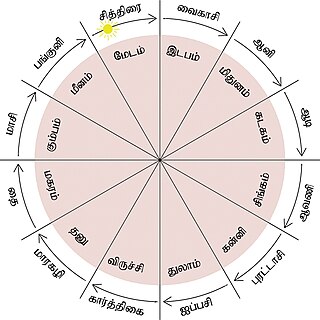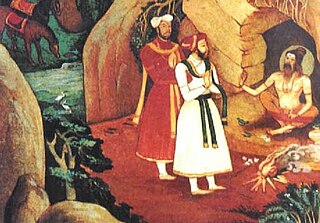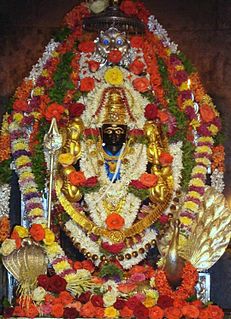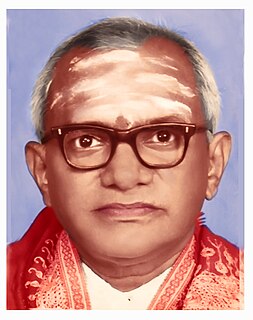
In mathematics, a permutation group is a group G whose elements are permutations of a given set M and whose group operation is the composition of permutations in G. The group of all permutations of a set M is the symmetric group of M, often written as Sym(M). The term permutation group thus means a subgroup of the symmetric group. If M = {1, 2, ..., n} then Sym(M) is usually denoted by Sn, and may be called the symmetric group on n letters.

In recreational mathematics, a square array of numbers, usually positive integers, is called a magic square if the sums of the numbers in each row, each column, and both main diagonals are the same. The order of the magic square is the number of integers along one side (n), and the constant sum is called the magic constant. If the array includes just the positive integers , the magic square is said to be normal. Some authors take magic square to mean normal magic square.
The following outline is provided as an overview of and topical guide to Hinduism:

A checkerboard or chequerboard is a board of checkered pattern on which checkers is played. Most commonly, it consists of 64 squares (8×8) of alternating dark and light color, typically green and buff, black and red, or black and white. An 8×8 checkerboard is used to play many other games, including chess, whereby it is known as a chessboard. Other rectangular square-tiled boards are also often called checkerboards.
A pandiagonal magic square or panmagic square is a magic square with the additional property that the broken diagonals, i.e. the diagonals that wrap round at the edges of the square, also add up to the magic constant.

The magic constant or magic sum of a magic square is the sum of numbers in any row, column, or diagonal of the magic square. For example, the magic square shown below has a magic constant of 15. For a normal magic square of order n – that is, a magic square which contains the numbers 1, 2, ..., n2 – the magic constant is .
An antimagic square of order n is an arrangement of the numbers 1 to n2 in a square, such that the sums of the n rows, the n columns and the two diagonals form a sequence of 2n + 2 consecutive integers. The smallest antimagic squares have order 4. Antimagic squares contrast with magic squares, where each row, column, and diagonal sum must have the same value.

Sringeri also called Shringeri is a hill town and Taluk headquarters located in Chikkamagaluru district in the Indian state of Karnataka. It is the site of the first maṭha established by Adi Shankara, Hindu theologian and exponent of the Advaita Vedanta philosophy, in the 8th century CE. Located on the banks of the river Tungā, the town draws a large number of pilgrims to its temples of Sri Sharadamba, Sri Vidyashankara, Sri Malahanikareshvara and other deities.

A magic hexagon of order n is an arrangement of numbers in a centered hexagonal pattern with n cells on each edge, in such a way that the numbers in each row, in all three directions, sum to the same magic constant M. A normal magic hexagon contains the consecutive integers from 1 to 3n2 − 3n + 1. It turns out that normal magic hexagons exist only for n = 1 and n = 3. Moreover, the solution of order 3 is essentially unique. Meng also gave a less intricate constructive proof.

The Tamil calendar is a sidereal solar calendar used by the Tamil people of the Indian subcontinent. It is also used in Puducherry, and by the Tamil population in Sri Lanka, Malaysia, Singapore, and Mauritius.

Vidyaranya, usually identified with Mādhavācharya, was Jagadguru of the Sringeri Sharada Peetham from ca. 1374-1380 until 1386 - according to tradition, after ordination at an old age, he took the name of Vidyaranya, and became the Jagadguru of this Matha at Sringeri.

The Shakti Pitha or the Shakti Peethas are significant shrines and pilgrimage destinations in Shaktism, the goddess-centric denomination in Hinduism. The shrines are dedicated to various forms of Adi Shakti. Various Puranas such as Srimad Devi Bhagavatam state the existence of varying number of 51, 64 and 108 Shakti peethas of which 18 are named as Astadasha Maha (major) in medieval Hindu texts.

Dakṣināmnāya Śrī Śāradā Pītham or Śri Śringeri Maṭha is one amongst the four cardinal pīthams following the Daśanāmi Sampradaya - the peetham or matha is said to have been established by acharya Śrī Ādi Śaṅkara to preserve and propagate Sanātana Dharma and Advaita Vedānta, the doctrine of non-dualism. Located in Śringerī in Chikmagalur district in Karnataka, India, it is the Southern Āmnāya Pītham amongst the four Chaturāmnāya Pīthams, with the others being the Dvārakā Śāradā Pītham (Gujarat) in the West, Purī Govardhana Pīṭhaṃ (Odisha) in the East and Badri Jyotishpīṭhaṃ (Uttarakhand) in the North. The head of the matha is called Shankarayacharya, the title derives from Adi Shankara.

Swami Chandrasekhara Bharati was the Jagadguru Sankaracarya of Sringeri Sharada Peetham in 1912–1954. He was one of the most significant spiritual figures in Hinduism during the 20th century. They were believed to be a Jivanmukta.

Sthānika Brāhmins belong to Hindu Tuluva Smartha Brahmin group.
Sacchidananda Bharati I , was a Hindu sant and religious leader of the 17th century. He was the Jagadguru of the Hindu matha Sringeri Sharada Peetham from 1623 to 1663, and is believed to have saved it from attack by spiritual means.

The Char Dham is a set of four pilgrimage sites in India. It is believed that visiting these sites helps achieve moksha (salvation). The four Dhams are, Badrinath, Dwarka, Puri and Rameswaram. It is believed that every Hindu should visit the Char Dhams during one's lifetime. The Char Dham as defined by Adi Shankaracharya consists of four Hindu pilgrimage sites. These main 'dhamas' are the shrines of Lord Vishnu and Rameshwaram is a shrine of lord Shiva. All the 'dhamas' are related to four epochs,(1) Dham of Satyuga- Badrinath, Uttarakhand (2) Dham of Tretayuga -Rameswaram, Tamil Nadu (3) Dham of Dwaparayuga - Dvaraka, Gujarat (4) Dham of Kaliyuga - Jagannatha Puri, Odisha.
Malladi Chandrasekhara Sastry was an Indian scholar and television personality who specialized in the Vedas and Puranas texts in the Telugu and Sanskrit languages. His works have included commentaries on All India Radio during Bhadrachalam's Sitarama Kalyanam and Brahmotsavam festivals. For Ugadi day, he recited the Panchanga Sravanam. On television he hosted a show Dharma Sandehalu and Dharma Sukshmalu where he answered questions regarding the Purana and various aspects of Hinduism. The show is telecast on the Sri Venkateswara Bhakti Channel and formerly on the Doordarshan Saptagiri Channel. He was the principal of a college run by the trust named Tirumala Tirupati Devasthanams where they do pravachan (lectures) on the Puranas. He received the Raja-Lakshmi Award in 2005, and has also been conferred the title of Purana Vachaspati.

Jagadguru Abhinava Vidyatirtha Mahaswami was the 35th Jagadguru of the Sringeri Sharada Peetham, which has been occupied by an unbroken lineage of gurus stretching back to the Advaitic philosopher Adi Shankaracharya, who established the matha for the propagation of Advaitha Vedanta.

Tummalapalli Ramalingeswara Rao was a Telugu poet, novelist, literary critic, philosophical journalist, writer of English prose and an exponent of Mantra Shastra and tradition. His works covered a wide range of subjects like history, sociology, literature, philosophy, religion and spiritualism. His popular works include Sri Lalitha Sahasranama Stotra Bhashyamu, Sri Chakra Vilasanamu, Sri Chakra Pooja Vidhanam, Dharmanirnayam, Tikkana Somayaji, Sivanugrahamu Pitruyagnamu (Poetry) and Sringeri Revisited.
10 Magic square Puzzles are the new kind of puzzles based on Arithmetic and Logic www.magicsquarepuzzles.com





















